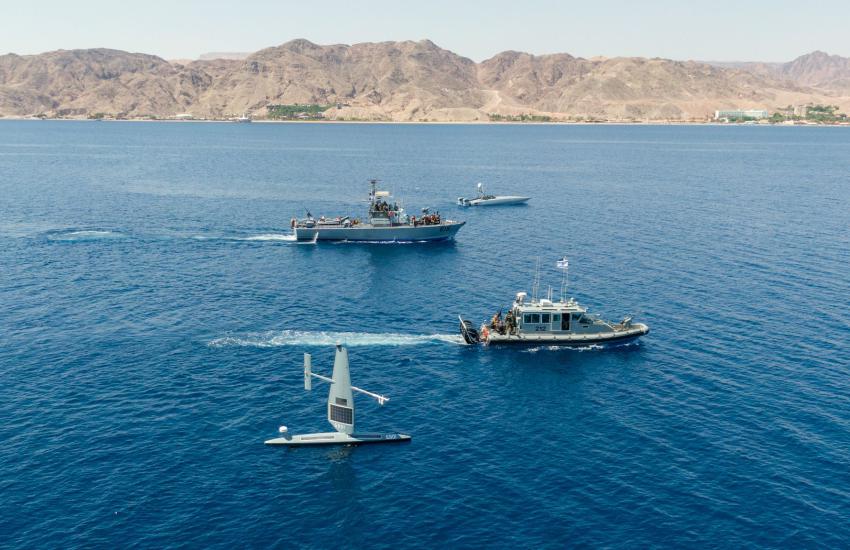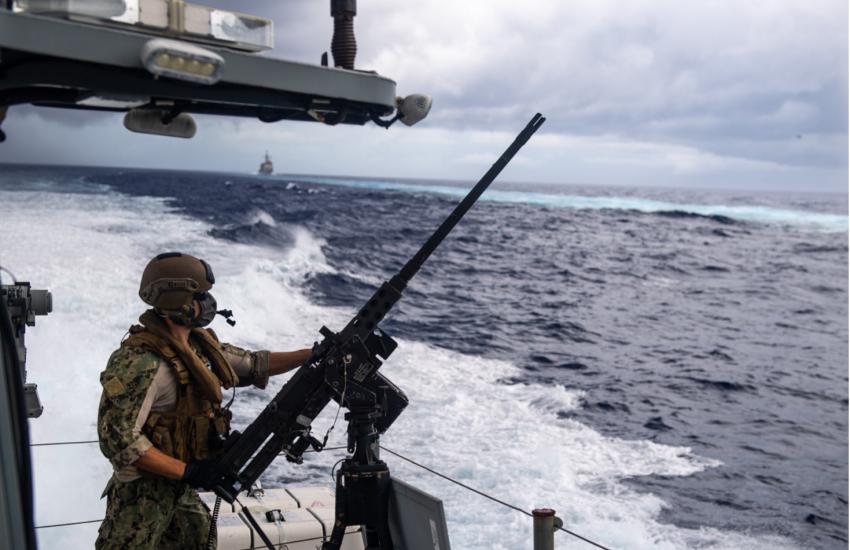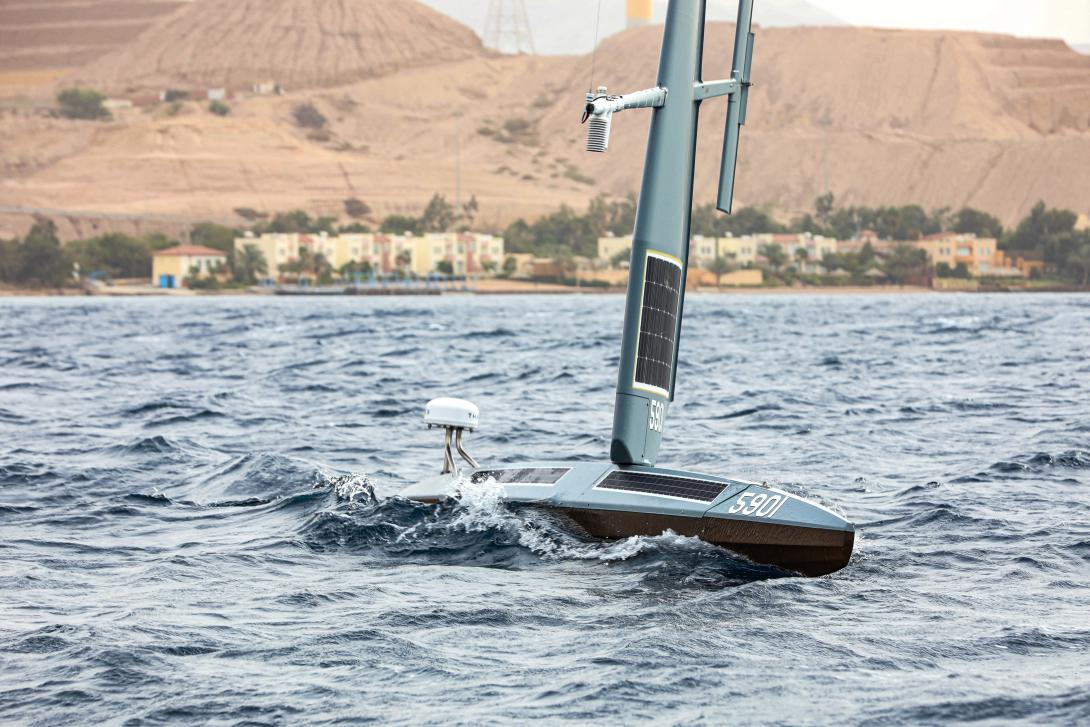Robotic Pawns: Unmanned Surface Vessels and Gray-Zone Warfare
The Cyber Edge Writing Contest 2nd-Place Winner, 2023
Floating at the crossroads of technological advancement and gray-zone warfare, the U.S. Navy’s unmanned surface vessel (USV) program is drifting toward a counterrevolution in the use of unmanned technologies. Recent incidents involving the seizure of USVs by China and Iran highlight unique legal challenges these adversaries exploit by using actions that are hard to detect and occur between peace and open conflict. USVs are becoming robotic pawns in the latest examples of gray-zone warfare perpetrated by China and Iran. Future concepts of operation and procurement programs must incorporate USV protection against gray-zone actions, or adversaries will gain the upper hand and prompt a counter-revolution in USV tactical employment.
Charged with an ambitious goal of employing 100 USVs by the end of 2023, the U.S. Fifth Fleet is at the forefront of incorporating technology and innovation in unmanned and autonomous systems into real-world operations. Recent events involving the seizure of U.S. Navy unmanned vessels by China and Iran showcase a distinction between the tactical employment of USVs and functional testing and experimentation. Adversaries are claiming subjective yet plausible justifications for why the seizures were acceptable, if not necessary, to ascertain the seaworthiness and ensure other vessels can operate safely in the vicinity of these U.S. Navy USVs.
Navy leaders are already beginning to recognize that they must either protect USVs or lose them. Unfortunately, many are suggesting that smaller USVs like the Saildrones seized by Iran must be designed to have no intrinsic value to U.S. adversaries. A resolution to the larger issue of how the Navy will protect USVs that may be employed with classified systems remains to be seen. Three recent incidents demonstrate the challenges associated with tactical employment of unmanned vessels in situations where adversaries can use gray-zone actions to interfere with them.
In December 2016, a Chinese rescue and salvage ship seized one of two U.S. low-buoyancy underwater glider drones from the survey ship USNS Bowditch (T-AGS-62) surveying in waters claimed as an exclusive economic zone by both China and the Philippines. The Chinese crew took the drone onboard for inspection. China later released a statement explaining that the confiscation was meant to prevent the device from posing a danger to the safe navigation of passing ships and personnel and then eventually returned it to the U.S. Navy.
More recently, an Iranian Revolutionary Guard Corps ship in the Arabian Gulf towed away a U.S. Navy Saildrone USV in August 2022, and in September 2022, an Iranian destroyer in the Red Sea picked up two U.S. Navy Saildrone USVs and hauled them onboard. In each case, the USVs were eventually returned. Iranian officials claim that their actions were justified in preventing possible accidents and supporting safe and secure shipping, even suggesting that the vessels’ navigation systems had failed. U.S. officials were steadfast in rebuking the Iranian interference with these USVs, calling the seizure inconsistent with the behavior of a professional maritime force and reiterating that the USVs are the sovereign property of the United States.
While the U.S. Navy strongly asserts that interfering with and seizing USVs are illegal activities, from Iran’s perspective, it was considered a professional contribution to the safety of navigation. Some initial reports even suggested that these Saildrones may have become disabled. If the USVs were disabled (actually or at least plausibly so), it would open the door for adversaries to cite the safety of navigation to justify seizing the vessels. Interfering with another nation’s USVs has become an opportunity in gray-zone warfare for U.S. adversaries. Not only is seizing these USVs a gray-zone action because the vessels are unmanned, but the ramifications of very real legal gray areas make it plausible for adversaries to tout a misleading narrative to justify their interference.
Several important issues surrounding USVs remain unsettled as a matter of international law. The myriad of open issues ranges from the status of USVs as “ships” or “vessels” to whether USVs can claim sovereign immunity as government-owned vessels.
Professional mariners have been conditioned not to trust automation. The U.S. Navy has done its fair share to perpetuate this distrust by building a historically strong safety record on a conservative approach to redundancies in human and equipment controls. As a result, it has been one of the longest holdouts across the maritime industries in fully embracing technologies like electronic charts, automated radar plotting aids and auto-pilot navigational modes. While there is merit in balancing risk management with innovation, this cultural mindset has inadvertently contributed to the creation of an opportunity for U.S. adversaries in gray-zone warfare. U.S. adversaries can plausibly claim an unmanned system is operating erratically or malfunctioning in some way, and thus it is prudent for the adversary to seize it and investigate further, adhering to a customary duty of mariners to remove such hazards for safe navigation. Questioning the level to which professional mariners can trust USVs is a plausible position, and U.S. adversaries are taking advantage of it.
The impact of incidents like the seizure of these USVs on customary law will depend upon whether they continue and whether a measured but benign U.S. response becomes the norm. This has also been the case when adversaries have attacked U.S. unmanned aerial vehicles, such as Iran’s destruction of a U.S. Navy RQ-4 Global Hawk in 2019. With each capture of a USV coupled with a limited or complete lack of response, another block in the wall of customary law is stacked around the United States ceding more opportunity in the gray zone to adversaries.
Many authors have debated the legal concerns associated with USVs. Still, nearly all of this debate has centered on either the legal status of these vessels or the legal ramifications related to the use of these vessels as the medium through which use of force is exercised. Perhaps the most significant matter relative to gray-zone warfare and USVs is the duty or ability of other mariners to determine whether a USV is operating safely or has become a hazard to navigation. Even though the issue of safety of navigation featured prominently in the three recent USV seizures explored here, there is little open discussion addressing the question of safety and hazards to navigation that USVs might present to other vessels.
Many of the reasons for protecting USVs are obvious. They can be expensive. They may have sensitive or even classified equipment onboard. Regardless of their status under international law, they are U.S. government property. But the second-order effects of failing to protect USVs are also worth consideration. For instance, the United States may risk giving up tactics, techniques and procedures to adversaries if a USV is captured. Or, if the United States loses a USV, it could provide inadvertent opportunities for violent extremist organizations to learn how to make their own terrorist delivery devices for weapons of mass destruction.


The U.S. Navy must incorporate protection into future concepts of operation for USV employment and USV procurement programs. The possible solutions for countering adversaries that use gray-zone actions against U.S. Navy USVs are not likely to be palatable because they will probably require human involvement. Thus, they may constrain the tactical employment of USVs and hamstring the incorporation of unmanned technologies into naval operations. Despite this, the U.S. Navy should explore an array of possible policies designed to protect USVs in tactical environments. These policies may include:
- Manned warships to provide overwatch for a certain number of USVs.
- A regional quick reaction force with an appropriate tether to respond should a USV suffer casualties or be interfered with by adversaries.
- Security of USVs in the form of armed overwatch platforms from other services.
- Embarked security teams (for larger USVs) as used similarly for unarmed or minimally armed vessels owned and operated by the U.S. government.
- USVs protecting themselves with some type of explosive self-destruct mechanism for deterrence to prevent classified or sensitive material from falling into the hands of enemies.
The future utility of USVs is at a critical juncture between innovation and gray-zone warfare, and the U.S. Navy must be prepared to incorporate USV protection and tactical employment into concepts of operation and procurement programs or risk having their tactical use constrained to the point of irrelevance. However, without proper incorporation of unmanned systems by human security personnel, the unique gray-zone legal challenges in which USVs operate will likely prompt new constraints on USV tactical employment rather than expansion into new missions.
Cmdr. Clayton Robinson is a retired U.S. Navy surface warfare officer and anti-terrorism/force protection specialist. Since 2017 he has worked for the Department of Defense as a strategic planning specialist at multiple combatant commands. He served at sea in USS Russell (DDG-59), USS Laboon (DDG-58), USS Nitze (DDG-94) and commanded Maritime Civil Affairs Squadron One (MCAS-1).






Comments